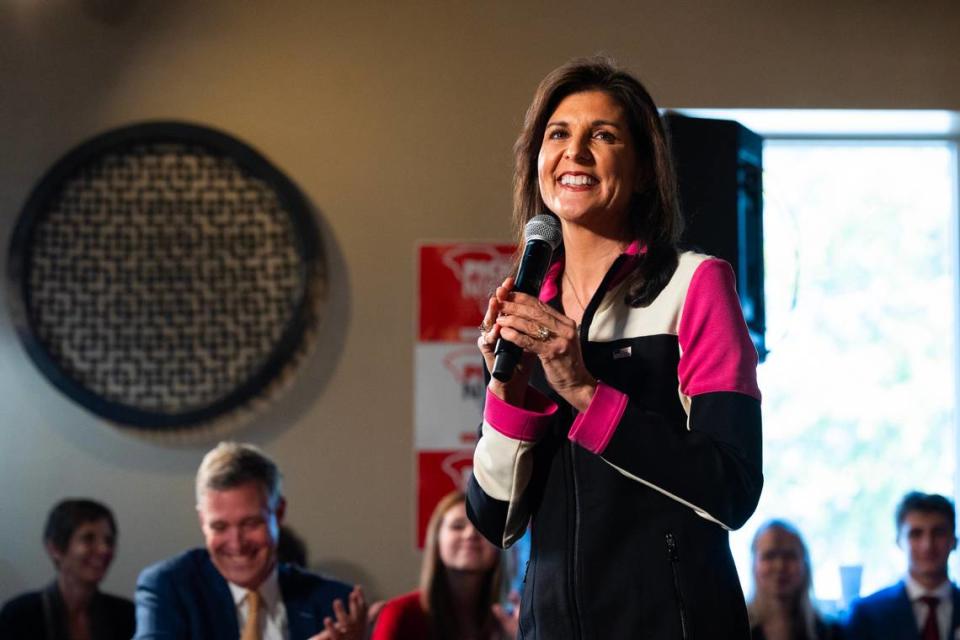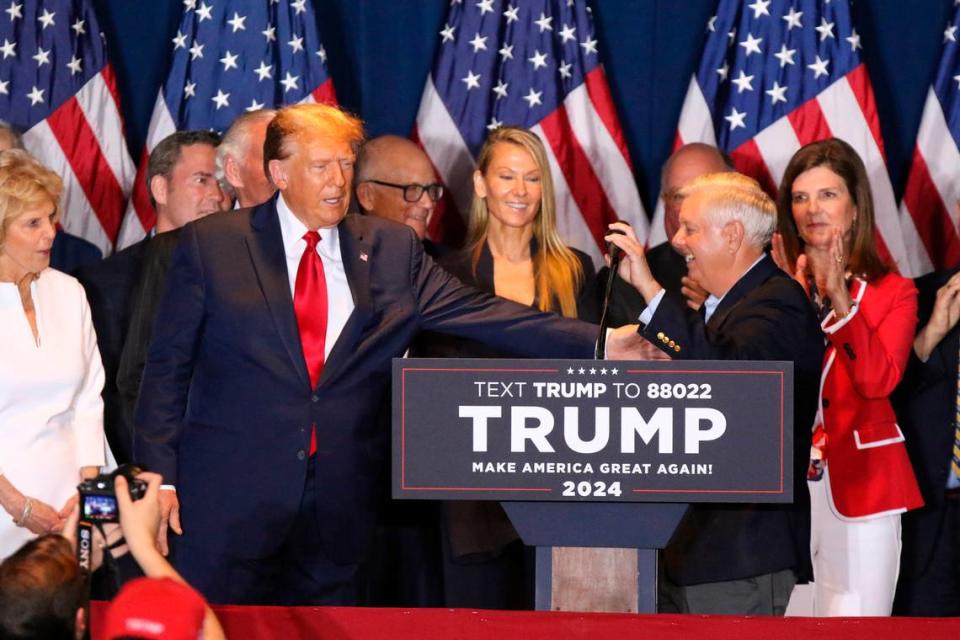SC GOP voters rejected Haley in primary. Does she have to reject them to beat Trump?
- Oops!Something went wrong.Please try again later.
- Oops!Something went wrong.Please try again later.
Former President Donald Trump cruised to a 20-point victory over former Gov. Nikki Haley on Saturday, a result closer than what most late polls projected in the race. However, Trump received widespread support in rural areas and two Republican strongholds.
Haley, who was elected governor with Tea Party backing, was rejected by 60% of the GOP primary voters. But for her to have a path to the nomination, or at least gain delegates, she’ll have to move on from the make up of South Carolina Republican voters.
Now as Haley moves onto Michigan and Super Tuesday states, she’ll have to move find voters who are not deeply conservative or don’t view themselves as part of the Make America Great Again movement.
Trump carried the Upstate, a heavily evangelical area of South Carolina. He also carried the Pee Dee, which includes the fastest growing county in the state fueled by Republican voters moving from blue states.
Haley carried three of the state’s 46 counties: Beaufort, Charleston and Richland.
Despite a poll by The Citadel that predicted Haley would do better among early voters, Trump had more support among those who cast a ballot ahead of primary election day.
Trump’s largest margins in terms of percentages were in rural areas, but he got his highest amount of votes in Greenville and Horry counties.
Haley’s campaign has said she is sticking in the campaign at least through Super Tuesday. In a memo released shortly before the New Hampshire Primary, her campaign signaled it was looking for people who may not traditionally vote in Republican primaries.
They often repeated the message in South Carolina that even though the state is ruby red, it has an open primary. They also pointed to the open or semi-open primaries in Virginia, Texas, Maine, Massachusetts, Minnesota, North Carolina and Vermont, all with favorable demographics.
“The reality is that the path through Super Tuesday includes more states than not that have this dynamic,” Haley Campaign Manager Betsy Ankney wrote in a January memo. “Independents voting in primaries is nothing new – historically, GOP nominees have relied on Independents as part of their path to victory, including Donald Trump in 2016. But in 2024, Nikki Haley is the beneficiary of those Independents – in both the Republican primaries and the general election.”
What do Haley counties look like?
Haley only won Beaufort, Charleston and Richland counties. Each of those counties have a higher percentage of people with a bachelors degree than the statewide percentage, according to the U.S. Census Bureau.
Charleston and Beaufort counties also have higher median incomes than the state median income, and people who are economic and fiscal conservatives.
“Those were voters that she had success with in the previous nominating state, New Hampshire, and they were voters, (through) paid efforts in addition to non-paid efforts, such as her bus tour, focused,” said Rob Godfrey, a longtime South Carolina political consultant who previously worked for Haley when she was governor, but stayed neutral leading up to the primary. “She was able to turn those voters out and they supported her. They are without question part of a coalition for however she continues to run in the race.”
With Haley’s victories in Charleston and Beaufort counties, she was able to win the First Congressional District, currently represented by U.S. Rep. Nancy Mace, R-Isle of Palms. The district was previously represented by U.S. Sen. Tim Scott. Both Mace and Scott endorsed Trump’s campaign.
Mace is facing a primary challenge from Catherine Templeton, who also is backing Trump’s candidacy, and being supportive of Trump is seen as beneficial for lawmakers in a primary election because of the state’s gerrymandered districts.
In 2022, Haley backed Mace’s successful reelection campaign in the primary when she was challenged by former state Rep. Katie Arrington, who was backed by Trump.

What did the South Carolina GOP electorate look like?
The GOP primary electorate became more evangelical and had less education compared to the 2016 electorate.
Among white voters in the primary, 60% considered themselves evangelical or born-again Christians, compared with 39% in the 2016 primary, a Reuters exit poll said.
However, only 43% of GOP primary voters have a college degree according to a Reuters exit poll. In 2016, 54% of GOP voters had a college degree.
According to the Associated Press’ VoteCast released shortly before polls closed, four in 10 voters said they think Trump is too extreme to win in November. Haley ended up receiving just under 40% of the vote.
The Reuters exit poll found 62% do not think President Joe Biden legitimately won the 2020 election. The same amount say Trump would still be fit for the presidency if he was convicted in his criminal case. The same exit poll showed the top issue for voters was immigration, in a state that has a 5.2% immigrant population, according to the Census Bureau.
Haley, a Charleston County resident, had support among those who know President Joe Biden legitimately won the 2020 election, and four in 10 of her supporters voted for Biden in 2020.
“That’s a function of the fact he’s talking about the issues that a lion share of Republican voters care the most about,” Godfrey said. “He is harnessing the anger and the emotion and weaponizing it against his political opponents most effectively and he’s mobilizing voters and turning them out in doing so.”
But Trump has yet to lose a nominating contest and his grip on the party has only strengthened as he’s on track to have a rematch with Biden in November’s general election.
Haley’s campaign, however, is continuing on despite a majority of those who have voted in Republican contests want to give Trump another chance.
“Nikki Haley is working to earn the support of 70% of voters who do not want a Trump-Biden rematch,” said Brittany Yanick, a Haley spokeswoman. “Just like in New Hampshire, she earned around 40% of the vote in South Carolina from voters who want to see an alternative to Trump, and she’s going to continue to fight to ensure voters have a choice.”

Did Democrats and independents vote?
Richland County, a heavily Democratic county, also supported Haley in the primary. Ahead of the primary, groups such as Independents Moving the Needle and Primary Pivot worked to get non Republican voters.
But they weren’t alone.
Stand for America Inc., social advocacy group founded Haley ran television ads to encourage those who didn’t vote on Feb. 3 to vote on Feb. 24. Haley is no longer involved with the organization. SFA Inc., a super PAC aligned with Haley also sent mailers to Democratic leaning voters encouraging them to vote for Haley.
But the biggest hint that there was a little more crossover voting may come from an advisory question on the ballot.
Voters overwhelmingly said yes to all three advisory questions on the ballot, but a question about whether should have the right to register by party only had 73% approval. In previous GOP primaries, the percentages supporting the idea was in the low to mid 80s.
In Saturday’s primary, less than 65% of voters in Richland and Charleston counties approved of the idea.
While many polls polls predicted a 30-to-35 point win for Trump, one poll predicted Haley would only lose by 22 percentage points because of participation by Democratic and independent voters.
The groups efforts may have swayed a few more people who may not traditionally vote in the Republican primary to cast a ballot, but it was no where near enough to change the result.
According to a Reuters exit poll, only 4% of primary voters, or about 30,000 of the 755,800 people voted in the primary, usually think of themselves as Democrats, compared with 2% in the party’s 2016 primary.
About 166,000, or 22%, of those who voted in the GOP primary consider themselves moderate or liberal. That share is up from 19% of GOP primary voters in 2016.

